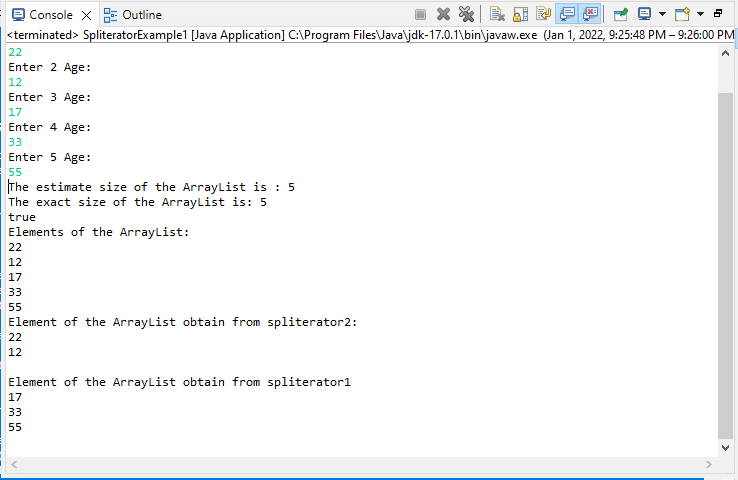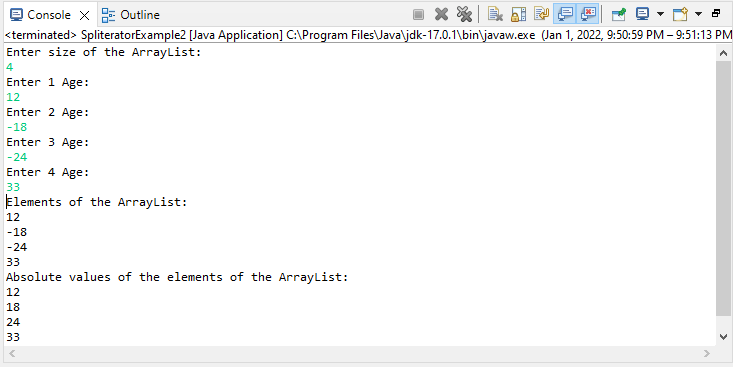Spliterator in java 8It is similar to the other iterators available in Java to traverse the elements of the source(Collection, Generator function or IO channel). Spliterator is a base utility for Streams, especially parallel ones. In order to use Spliterator for collections, we create an object of Spliterator by calling the spliterator() method available in the Collection interface. The Spliterator interface provides the following eight methods: 1. characteristics()it is one of the most import method which is used to get the set of characteristics of this Spliterator and its elements. The returned result is from the following:
The syntax of characteristics() method is as follows: The characteristics() method accepts no parameter and returns the characteristics of the invoking spliterator that are encoded into an integer value. 2. estimateSize()The estimateSize() method is used to get the estimate of the number of elements that are left to iterate. It returns Long.MAX_VALUE if the source is infinite, unknown or too expensive to compute. The syntax of the estimateSize() method is as follows: The estimateSize() method accepts no parameter and returns the estimate of the number of elements that are left to iterate. 3. getExactSizeIfKnown()It is similar to the estimateSize() method. The only difference is that the getExactSizeIfKnown() method returns -1 if the source is infinite, unknown or too expensive to compute. The syntax of the getExactSizeIfKnown() method is as follows: The method accepts no parameter and returns the number of elements that are left to iterate. 4. getComparator()it is used to sort the Spliterator's source. The sorting is done by a Comparator and returns that comparator as a result. The syntax of the getComparator() method is as follows: The getComparator() method accepts no parameter and returns the following values and exceptions:
5. hasCharacteristics()The hasCharacteristics() method is used to identify whether the Spilitirator's characteristics include all the given characteristics or not. The syntax of the hasCharacteristics() method is as follows: The hasCharacteristics() method accepts characteristics as a parameter and returns true or false when the given characteristics are present in the spliterator. 6. tryAdvance(Consumer <?super T> action)The tryAdvance() method is used to perform the given action on the remaining elements and returns true. If elements are not present, it returns false. The given action will be performed on the next element in encounter order when the Spliterator is ordered. The syntax of tryAdvance() method is as follows: The tryAdvance() method accepts action as a parameter. It returns true if there is a next element and false when elements remain. It can also throw NullPointerException When the specified action is null. 7. forEachRemaining(Consumer<?super T> action)The forEachRemaining() method is used to perform the given action on each element sequentially in the current thread. It performs action until the action throws NullPointerException or all the elements have been processed. Actions are performed in encounter order when the spliterator is ordered. The forEachRemaining() method has the following syntax: The forEachRemaining() method accepts action as a parameter and returns void. The forEachRemaining() method also throws NullPointerException when the specified action is null. 8. Spliterator <T> trySplit()The trySplit() method spit the spliterator only if possible and return a reference to a new spliterator for the partition. It returns null when splitting is not possible of the spliterator. If the splitting process is done successfully, the original spliterator iterates over one portion of the sequence and the returned spliterator iterates over the other portion. The syntax of the trySplit() method is as follows: The trySplit() method accepts no parameter and returns a Spliterator covering some portion of the elements or null when the spliterator cannot be split. Let's takes some example to understand the working of all the above discussed methods. SpliteratorExample1.java Output: 
SpliteratorExample2.java Output: 
Next TopicTree Model Nodes in Jackson
|
 For Videos Join Our Youtube Channel: Join Now
For Videos Join Our Youtube Channel: Join Now
Feedback
- Send your Feedback to [email protected]
Help Others, Please Share










